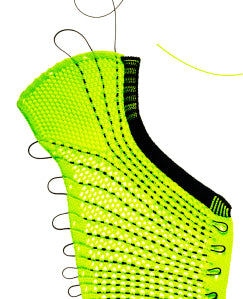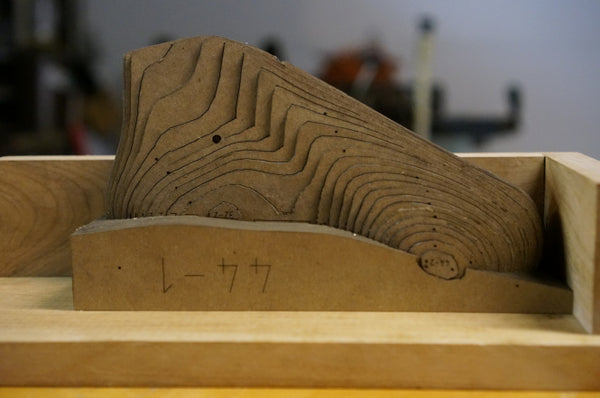The most pertinent thing about SFT, for the Meetup audience, would be a discussion of how we are leveraging digital manufacturing techniques to bring customized shoes to climbers. Because climbing shoes fit so tightly and human feet vary so widely, SFT has had to rethink traditional shoe manufacturing so that our process can accommodate natural variations efficiently (i.e. to bring custom shoes to as many climbers as possible at the least environmental cost). We are pursuing digital manufacturing because we assume that the shoe fits the climber, instead of stuffing climbers into generic shoes.
 When people say "digital manufacturing," almost everyone jumps to the idea of 3D printing the whole shoe, but right now (due to the materials available, print time, print volumes, etc.), that's not really feasible. Of course, "shoes" have been 3D printed, but they're stiff sculptures, not engineered tools that complement the wearer's biomechanics. Instead of trying force a product into the requirements of one limited manufacturing process, SFT believes in choosing materials and digital techniques suited to the product’s requirements.
When people say "digital manufacturing," almost everyone jumps to the idea of 3D printing the whole shoe, but right now (due to the materials available, print time, print volumes, etc.), that's not really feasible. Of course, "shoes" have been 3D printed, but they're stiff sculptures, not engineered tools that complement the wearer's biomechanics. Instead of trying force a product into the requirements of one limited manufacturing process, SFT believes in choosing materials and digital techniques suited to the product’s requirements.
Nike and Adidas' knitted upper method is a great example of leveraging a digitally controlled machine to obviate the need for part tooling. Here, making rule dies for pattern cutting, cutting the patterns out of sheet stock and wasting some of it, and then stitching it all together has been eliminated or minimized. Critically, by eliminating the need for expensive tooling specific to each shoe style and size, knitted uppers can reduce the pressure to mass-produce shoes.
The shoemaking process has many such pressure points where traditional techniques have relied heavily on fixed tooling. For example, lasts are cut in every size (and left and right) for a specific shoe design. Cutting so many lasts can be expensive upfront, so many manufacturers have stopped offering different widths to reduce tooling costs. However, with a parametric last model and a laser cutter, SFT can make quick-turn, durable, and recyclable custom lasts. When a customer places an order, the last model is reconfigured in a couple of minutes to match the critical features of their foot. In another 2 hours, we can complete a last that's ready to build a shoe on. By making our lasts on demand, we aren’t wedded to a precut scale of sizes. By making the lasts quick-turn and recyclable, we can make lasts only when needed, storing the digital information necessary to create them.

Besides the lasts, there are lots of other steps in making climbing shoes which need rethinking to better support customization and to reduce our industry's waste and reliance on outsourced labor. That's the stuff that wakes me up in the middle of the night (luckily there's a whiteboard next to the bed to brainstorm on). SFT's long-term commitment to digital manufacturing is what I wanted to communicate to the people at the hardware meetup. In the process of compiling my thoughts before speaking there, I realized that SFT has a vision, a manifesto, if you will. This vision of what we can give to the climbing community is what drives us forward:
SFT Climbing leverages digital manufacturing techniques to make shoes that fit real feet. We're applying the right technology to each step in the manufacturing process so that we can do what's best for climbers and for the world that we climb in.
The SFT lightning talk on youtube:
]]>"Why do you climb?"
When I fell off the wall for the 50th time and reluctantly pulled off my two-sizes small shoes, I had to follow that question with,
"Why do you perform these rituals in your sports?" and,
"Do all of them make sense?"
For example, the on-belay call and response, as nursery-rhyme-like as it is, is intended to be a reflex safety check. Properly storing food in the backcountry decreases the chance of an unpleasant wildlife encounter. These rituals make sense.
Taking off my shoes between every attempt on a boulder problem because they're too tight to limp across the mats in… now that seems pointless.
Of course, I could wear looser, more comfortable shoes, but I've gotten used to the lovely edging experience afforded by binding one’s feet into tiny shoes. Crushing my toes into curled claws with taut suede makes them an extension of the longitudinal arches in my feet, effectively distributing large loads through my entire foot. I don't want to compromise on that kind of capability.
But I am compromising. I'm compromising comfort, which also affects performance. Additionally, constantly donning and doffing shoes is a waste of time. Something is fundamentally wrong with this part of the ritual.
When friends discussed carrying extra shoes up a multi-pitch trad route to have their super down-turned pair for a single pitch, my engineer's desire for efficiency was outraged. This was the same problem I was having at the base of 15 foot boulders! There had to be some way to design this problem away because there was so much redundancy. Performance climbing shoes shouldn't engender compromise.
Determined not to compromise, I set out to pare down to the essentials of climbing shoes so that every "Why?" would have a reasonable answer. None of the glorious struggle that is climbing should be menial. No more fumbling at the base of a climb with shoes too tight to put on. No more multiple pairs to haul on trips and to the gym. SFT Climbing's first shoe should perform unassumingly, in all different disciplines, just the way you want it.
You should be able to point to every single piece of the shoe and ask “Why?” and get a good answer from the designer.
The climbers who wear it should be able to ask that of me. About every material choice, every angle, and each mechanism.
Because this is the way SFT was born. My question is, Why compromise?
]]>